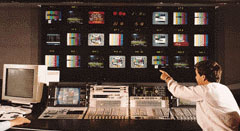This article looks briefly at media policy and law in a pan - European context. Although there are several organizations working at this level, the focus is mainly on the European Community, but it is understood that its work is heavily influenced and assisted by the (legally) less directive Council of Europe which can claim to be the primary inter-governmental body in this field - at least chronologically. The Community's overall approach alternates between treating the media sector as a cultural good or an economic commodity. The Council is rather less ambivalent; the media are simultaneously both the means for realizing the human right of freedom of expression and a principal condition for consolidating democracy or bringing it about in certain areas of the European audio-visual area. Generally, the Council's activities build a cumulative normative framework for media and communications based on certain, specific values.
European Community
The earliest, and some would claim the more effective, framework for national co-operation and co-ordination occurs through non-governmental associations, such as the European Broadcasting Union/Union Europeenne de Radio-Television. This was set up in 1950, when 23 radio and tv organisations from both Europe and the Mediterranean Basin met, as successor to the International Broadcasting Union which was established as early as 1925. More recently, ACT-the Association of Commercial Television-has been set up as the commercial counterpart of the EBU, which increasingly has been perceived as the voice of the public service.
Arguably, these bodies have moved from pure co-operation and collaboration between national broadcasters to becoming significant political lobby networks aimed at Brussels and Strasbourg. The themes of these associations have determined that "media" is principally understood in Europe to mean audio-visual broadcasting (with the emphasis on television whether terrestrial, by cable or satellite). Inevitably, however, convergence means that the category is becoming less watertight and this will be reflected in future European policy and organization. Moreover, since the European Community has embraced the concept of the Information Society, and media is now getting placed within this framework.
Reinforcement of Industry
Although the border between the fields of telecommunications and broadcasting is beginning to shift, the mass media have been so far a separate field of legislative activities. Responsibility for policy in this area belongs to the Directorate General for Information, Communication, Culture and Audio-visual. The development of an audio-visual Policy by the European Union has a twofold objective: "to establish and ensure the functioning of a true European space for audio-visual services and to contribute to developing a strong, forward-looking programme industry that can compete on world markets and help European culture to flourish and create jobs in Europe". In addition to these objectives, the Commission monitors closely the emergence and development of new audio-visual and information services, with emphasis on their impact on creation, communication and fundamental rights. Two major regulatory instruments are used: support systems for the audio-visual industry and legal norms.
Anxious to promote a stronger and more competitive audio-visual industry and to support mechanisms which complement member States' actions in this field, the EC has devised a strategy based on encouraging training for professionals, supporting the production and distribution of European audio-visual works and ensuring that there are no internal frontiers within the Community to the distribution of broadcasts from within any member state. Thus Media II will spend ECU 45 million over five years in support of training of audio-visual professionals and ECU 265 million over five years on development and of production projects distribution of audio-visual products, supplemented by a European Guarantee Fund to mobilize investment in the programme industry. The Action Plan for the introduction of advanced television services in Europe has provided financial support to cover part of the additional cost involved in adjusting new and existing programmes technically for 16:9 format so extending the shelf-life of European catalogues. In addition, the free circulation of broadcasting services, as organized by the "Television without Frontiers" directive contributes, through the promotion of production and distribution of European works, to the reinforcement of the programme industry.
  European Community is anxious to promote a stronger and more competitive audio-visual industry in Europe. |
Television Without Frontiers
The Treaties, the "constitution" of the Community, contain a large number of articles relevant to the audio-visual policy including 9,12,30 and 31(free movement of goods), and 48 to 66 (freedom of movement of workers, right of establishment and freedom to provide services). In addition article 127 provides for professional training projects, article 128 for promoting culture and article 130 for industrial policy initiatives. Competition rules and common commercial policy also play a significant role in this sector. Finally the recent adopted Treaty of Amsterdam contains a new protocol on Public Service Broadcasting which aims at securing the right of member states to continue funding such broadcasting.
The main legal instrument of the Community in this field is the "Television Without frontiers" directive, which implements the free circulation of services principle in broadcasting, thus creating the basis of a true European audio-visual area. Adopted in 1989 and amended in 1997, this directive provides for a minimum set of common rules concerning advertising, protection of minors, events of major importance to the public (particularly sports), right of reply and promotion of European works. Member States shall ensure broadcasters under their jurisdiction respect those rules and must refrain from any restriction on reception of broadcasts coming from other member states.
Media Framework
Turning now briefly to the Council of Europe, the Council's Intergovernmental Action Plan states that its main instrument of media regulation, the European Convention on Transfrontier Television will, throughout 1997, remain the key reference point in this field of constant technological change. The Convention sets out principles concerning the rights of viewers; duties of states; programming standards; advertising and sponsorship. The purpose of the Convention is to achieve a framework for the transfrontier circulation of television programmers. It does not seek to regulate the broadcasting activities, policies and structures of the member state. Recently the Convention's standing committee has particularly involved in monitoring the progress of the revision of the EC "Television Without Frontiers" directive, "with a view to examining any amendments which should be made to the Convention in order to maintain a coherence between the two instruments."
At the time of writing, a wide debate on the role of media policy within the context of convergence is taking place in Europe. The European Commission published at the end of September their long awaited Green Paper on the Regulatory Implications of Convergence, and the European Ministerial Conference on Mass Media Policy of the Council of Europe, to be held in December, will look at similar issues. How these concerns and the general impact of the convergence phenomenon on the existing body of regulation will be materialized in new initiatives remains to be seen.


